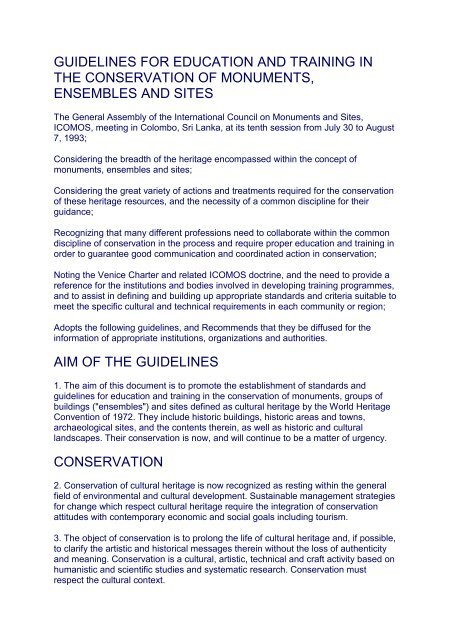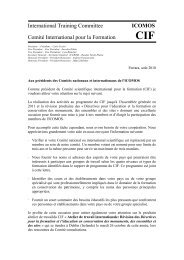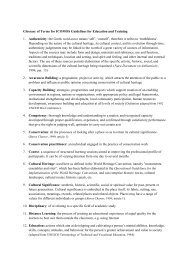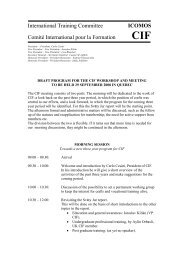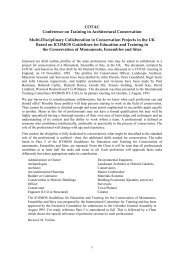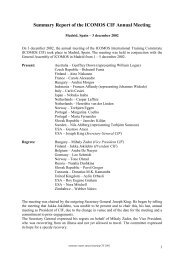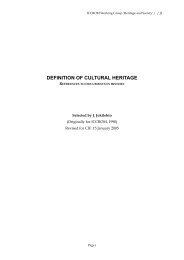guidelines for education and training in the ... - CIF - Icomos
guidelines for education and training in the ... - CIF - Icomos
guidelines for education and training in the ... - CIF - Icomos
Create successful ePaper yourself
Turn your PDF publications into a flip-book with our unique Google optimized e-Paper software.
GUIDELINES FOR EDUCATION AND TRAINING IN<br />
THE CONSERVATION OF MONUMENTS,<br />
ENSEMBLES AND SITES<br />
The General Assembly of <strong>the</strong> International Council on Monuments <strong>and</strong> Sites,<br />
ICOMOS, meet<strong>in</strong>g <strong>in</strong> Colombo, Sri Lanka, at its tenth session from July 30 to August<br />
7, 1993;<br />
Consider<strong>in</strong>g <strong>the</strong> breadth of <strong>the</strong> heritage encompassed with<strong>in</strong> <strong>the</strong> concept of<br />
monuments, ensembles <strong>and</strong> sites;<br />
Consider<strong>in</strong>g <strong>the</strong> great variety of actions <strong>and</strong> treatments required <strong>for</strong> <strong>the</strong> conservation<br />
of <strong>the</strong>se heritage resources, <strong>and</strong> <strong>the</strong> necessity of a common discipl<strong>in</strong>e <strong>for</strong> <strong>the</strong>ir<br />
guidance;<br />
Recogniz<strong>in</strong>g that many different professions need to collaborate with<strong>in</strong> <strong>the</strong> common<br />
discipl<strong>in</strong>e of conservation <strong>in</strong> <strong>the</strong> process <strong>and</strong> require proper <strong>education</strong> <strong>and</strong> <strong>tra<strong>in</strong><strong>in</strong>g</strong> <strong>in</strong><br />
order to guarantee good communication <strong>and</strong> coord<strong>in</strong>ated action <strong>in</strong> conservation;<br />
Not<strong>in</strong>g <strong>the</strong> Venice Charter <strong>and</strong> related ICOMOS doctr<strong>in</strong>e, <strong>and</strong> <strong>the</strong> need to provide a<br />
reference <strong>for</strong> <strong>the</strong> <strong>in</strong>stitutions <strong>and</strong> bodies <strong>in</strong>volved <strong>in</strong> develop<strong>in</strong>g <strong>tra<strong>in</strong><strong>in</strong>g</strong> programmes,<br />
<strong>and</strong> to assist <strong>in</strong> def<strong>in</strong><strong>in</strong>g <strong>and</strong> build<strong>in</strong>g up appropriate st<strong>and</strong>ards <strong>and</strong> criteria suitable to<br />
meet <strong>the</strong> specific cultural <strong>and</strong> technical requirements <strong>in</strong> each community or region;<br />
Adopts <strong>the</strong> follow<strong>in</strong>g <strong>guidel<strong>in</strong>es</strong>, <strong>and</strong> Recommends that <strong>the</strong>y be diffused <strong>for</strong> <strong>the</strong><br />
<strong>in</strong><strong>for</strong>mation of appropriate <strong>in</strong>stitutions, organizations <strong>and</strong> authorities.<br />
AIM OF THE GUIDELINES<br />
1. The aim of this document is to promote <strong>the</strong> establishment of st<strong>and</strong>ards <strong>and</strong><br />
<strong>guidel<strong>in</strong>es</strong> <strong>for</strong> <strong>education</strong> <strong>and</strong> <strong>tra<strong>in</strong><strong>in</strong>g</strong> <strong>in</strong> <strong>the</strong> conservation of monuments, groups of<br />
build<strong>in</strong>gs ("ensembles") <strong>and</strong> sites def<strong>in</strong>ed as cultural heritage by <strong>the</strong> World Heritage<br />
Convention of 1972. They <strong>in</strong>clude historic build<strong>in</strong>gs, historic areas <strong>and</strong> towns,<br />
archaeological sites, <strong>and</strong> <strong>the</strong> contents <strong>the</strong>re<strong>in</strong>, as well as historic <strong>and</strong> cultural<br />
l<strong>and</strong>scapes. Their conservation is now, <strong>and</strong> will cont<strong>in</strong>ue to be a matter of urgency.<br />
CONSERVATION<br />
2. Conservation of cultural heritage is now recognized as rest<strong>in</strong>g with<strong>in</strong> <strong>the</strong> general<br />
field of environmental <strong>and</strong> cultural development. Susta<strong>in</strong>able management strategies<br />
<strong>for</strong> change which respect cultural heritage require <strong>the</strong> <strong>in</strong>tegration of conservation<br />
attitudes with contemporary economic <strong>and</strong> social goals <strong>in</strong>clud<strong>in</strong>g tourism.<br />
3. The object of conservation is to prolong <strong>the</strong> life of cultural heritage <strong>and</strong>, if possible,<br />
to clarify <strong>the</strong> artistic <strong>and</strong> historical messages <strong>the</strong>re<strong>in</strong> without <strong>the</strong> loss of au<strong>the</strong>nticity<br />
<strong>and</strong> mean<strong>in</strong>g. Conservation is a cultural, artistic, technical <strong>and</strong> craft activity based on<br />
humanistic <strong>and</strong> scientific studies <strong>and</strong> systematic research. Conservation must<br />
respect <strong>the</strong> cultural context.
EDUCATIONAL AND TRAINING PROGRAMMES AND<br />
COURSES<br />
4. There is a need to develop a holistic approach to our heritage on <strong>the</strong> basis of<br />
cultural pluralism <strong>and</strong> diversity, respected by professionals, craftspersons <strong>and</strong><br />
adm<strong>in</strong>istrators. Conservation requires <strong>the</strong> ability to observe, analyze <strong>and</strong> syn<strong>the</strong>size.<br />
The conservationist should have a flexible yet pragmatic approach based on cultural<br />
consciousness which should penetrate all practical work, proper <strong>education</strong> <strong>and</strong><br />
<strong>tra<strong>in</strong><strong>in</strong>g</strong>, sound judgement <strong>and</strong> a sense of proportion with an underst<strong>and</strong><strong>in</strong>g of <strong>the</strong><br />
community's needs. Many professional <strong>and</strong> craft skills are <strong>in</strong>volved <strong>in</strong> this<br />
<strong>in</strong>terdiscipl<strong>in</strong>ary activity.<br />
5. Conservation works should only be entrusted to persons competent <strong>in</strong> <strong>the</strong>se<br />
specialist activities. Education <strong>and</strong> <strong>tra<strong>in</strong><strong>in</strong>g</strong> <strong>for</strong> conservation should produce from a<br />
range of professionals, conservationists who are able to:<br />
read a monument, ensemble or site <strong>and</strong> identify its emotional, cultural <strong>and</strong> use<br />
significance;<br />
underst<strong>and</strong> <strong>the</strong> history <strong>and</strong> technology of monuments, ensembles or sites <strong>in</strong> order to<br />
def<strong>in</strong>e <strong>the</strong>ir identity, plan <strong>for</strong> <strong>the</strong>ir conservation, <strong>and</strong> <strong>in</strong>terpret <strong>the</strong> results of this<br />
research;<br />
underst<strong>and</strong> <strong>the</strong> sett<strong>in</strong>g of a monument, ensemble or site, <strong>the</strong>ir contents <strong>and</strong><br />
surround<strong>in</strong>gs, <strong>in</strong> relation to o<strong>the</strong>r build<strong>in</strong>gs, gardens or l<strong>and</strong>scapes;<br />
f<strong>in</strong>d <strong>and</strong> absorb all available sources of <strong>in</strong><strong>for</strong>mation relevant to <strong>the</strong> monument,<br />
ensemble or site be<strong>in</strong>g studied;<br />
underst<strong>and</strong> <strong>and</strong> analyze <strong>the</strong> behaviour of monuments, ensembles <strong>and</strong> sites as<br />
complex systems;<br />
diagnose <strong>in</strong>tr<strong>in</strong>sic <strong>and</strong> extr<strong>in</strong>sic causes of decay as a basis <strong>for</strong> appropriate action;<br />
<strong>in</strong>spect <strong>and</strong> make reports <strong>in</strong>telligible to non-specialist readers of monuments,<br />
ensembles or sites, illustrated by graphic means such as sketches <strong>and</strong> photographs;<br />
know, underst<strong>and</strong> <strong>and</strong> apply Unesco conventions <strong>and</strong> recommendations, <strong>and</strong><br />
ICOMOS <strong>and</strong> o<strong>the</strong>r recognized Charters, regulations <strong>and</strong> <strong>guidel<strong>in</strong>es</strong>;<br />
make balanced judgements based on shared ethical pr<strong>in</strong>ciples, <strong>and</strong> accept<br />
responsibility <strong>for</strong> <strong>the</strong> long-term welfare of cultural heritage;<br />
recognize when advice must be sought <strong>and</strong> def<strong>in</strong>e <strong>the</strong> areas of need of study by<br />
different specialists, e.g. wall pa<strong>in</strong>t<strong>in</strong>gs, sculpture <strong>and</strong> objects of artistic <strong>and</strong> historical<br />
value, <strong>and</strong>/or studies of materials <strong>and</strong> systems;<br />
give expert advice on ma<strong>in</strong>tenance strategies, management policies <strong>and</strong> <strong>the</strong> policy<br />
framework <strong>for</strong> environmental protection <strong>and</strong> preservation of monuments <strong>and</strong> <strong>the</strong>ir<br />
contents, <strong>and</strong> sites;<br />
document works executed <strong>and</strong> make same accessible;<br />
work <strong>in</strong> multi-discipl<strong>in</strong>ary groups us<strong>in</strong>g sound methods;<br />
be able to work with <strong>in</strong>habitants, adm<strong>in</strong>istrators <strong>and</strong> planners to resolve conflicts <strong>and</strong><br />
to develop conservation strategies appropriate to local needs, abilities <strong>and</strong> resources;<br />
AIMS OF COURSES<br />
6. There is a need to impart knowledge of conservation attitudes <strong>and</strong> approaches to<br />
all those who may have a direct or <strong>in</strong>direct impact on cultural property.
7. The practice of conservation is <strong>in</strong>terdiscipl<strong>in</strong>ary; it <strong>the</strong>re<strong>for</strong>e follows that courses<br />
should also be multidiscipl<strong>in</strong>ary. Professionals, <strong>in</strong>clud<strong>in</strong>g academics <strong>and</strong> specialized<br />
craftspersons, who have already received <strong>the</strong>ir normal qualification will need fur<strong>the</strong>r<br />
<strong>tra<strong>in</strong><strong>in</strong>g</strong> <strong>in</strong> order to become conservationists; equally those who seek to act<br />
competently <strong>in</strong> historic environment.<br />
8. Conservationists should ensure that all artisans <strong>and</strong> staff work<strong>in</strong>g on a monument,<br />
ensemble or site respect its significance.<br />
9. Tra<strong>in</strong><strong>in</strong>g <strong>in</strong> disaster preparedness <strong>and</strong> <strong>in</strong> methods of mitigat<strong>in</strong>g damage to cultural<br />
property, by streng<strong>the</strong>n<strong>in</strong>g <strong>and</strong> improv<strong>in</strong>g fire prevention <strong>and</strong> o<strong>the</strong>r security<br />
measures, should be <strong>in</strong>cluded <strong>in</strong> courses.<br />
10. Traditional crafts are a valuable cultural resource. Craftspersons, already with<br />
high level manual skills, should be fur<strong>the</strong>r tra<strong>in</strong>ed <strong>for</strong> conservation work with<br />
<strong>in</strong>struction <strong>in</strong> <strong>the</strong> history of <strong>the</strong>ir craft, historic details <strong>and</strong> practices, <strong>and</strong> <strong>the</strong> <strong>the</strong>ory of<br />
conservation with <strong>the</strong> need <strong>for</strong> documentation. Many historic skills will have to be<br />
recorded <strong>and</strong> revived.<br />
ORGANIZATION OF EDUCATION AND TRAINING<br />
11. Many satisfactory methods of achiev<strong>in</strong>g <strong>the</strong> required <strong>education</strong> <strong>and</strong> <strong>tra<strong>in</strong><strong>in</strong>g</strong> are<br />
possible. Variations will depend on traditions <strong>and</strong> legislation, as well as on<br />
adm<strong>in</strong>istrative <strong>and</strong> economic context of each cultural region. The active exchange of<br />
ideas <strong>and</strong> op<strong>in</strong>ions on new approaches to <strong>education</strong> <strong>and</strong> <strong>tra<strong>in</strong><strong>in</strong>g</strong> between national<br />
<strong>in</strong>stitutes <strong>and</strong> at <strong>in</strong>ternational levels should be encouraged. Collaborative network of<br />
<strong>in</strong>dividuals <strong>and</strong> <strong>in</strong>stitutions is essential to <strong>the</strong> success of this exchange.<br />
12. Education <strong>and</strong> sensitization <strong>for</strong> conservation should beg<strong>in</strong> <strong>in</strong> schools <strong>and</strong><br />
cont<strong>in</strong>ue <strong>in</strong> universities <strong>and</strong> beyond. These <strong>in</strong>stitutions have an important role <strong>in</strong><br />
rais<strong>in</strong>g visual <strong>and</strong> cultural awareness - improv<strong>in</strong>g ability to read <strong>and</strong> underst<strong>and</strong> <strong>the</strong><br />
elements of our cultural heritage - <strong>and</strong> giv<strong>in</strong>g <strong>the</strong> cultural preparation needed by<br />
c<strong>and</strong>idates <strong>for</strong> specialist <strong>education</strong> <strong>and</strong> <strong>tra<strong>in</strong><strong>in</strong>g</strong>. Practical h<strong>and</strong>s-on <strong>tra<strong>in</strong><strong>in</strong>g</strong> <strong>in</strong> craft<br />
work should be encouraged.<br />
13. Courses <strong>for</strong> cont<strong>in</strong>u<strong>in</strong>g professional development can enlarge on <strong>the</strong> <strong>in</strong>itial<br />
<strong>education</strong> <strong>and</strong> <strong>tra<strong>in</strong><strong>in</strong>g</strong> of professionals. Long-term, part-time courses are a valuable<br />
method <strong>for</strong> advanced teach<strong>in</strong>g, <strong>and</strong> useful <strong>in</strong> major population centres. Short courses<br />
can enlarge attitudes, but cannot teach skills or impart profound underst<strong>and</strong><strong>in</strong>g of<br />
conservation. They can help <strong>in</strong>troduce concepts <strong>and</strong> techniques of conservation <strong>in</strong><br />
<strong>the</strong> management of <strong>the</strong> built <strong>and</strong> natural environment <strong>and</strong> <strong>the</strong> objects with<strong>in</strong> it.<br />
14. Participants <strong>in</strong> specialist courses should be of a high calibre normally hav<strong>in</strong>g had<br />
appropriate <strong>education</strong> <strong>and</strong> <strong>tra<strong>in</strong><strong>in</strong>g</strong> <strong>and</strong> practical work<strong>in</strong>g experience. Specialist<br />
courses should be multidiscipl<strong>in</strong>ary with core subjects <strong>for</strong> all participants, <strong>and</strong> optional<br />
subjects to extend capacities <strong>and</strong>/or to fill <strong>the</strong> gaps <strong>in</strong> previous <strong>education</strong> <strong>and</strong><br />
<strong>tra<strong>in</strong><strong>in</strong>g</strong>. To complete <strong>the</strong> <strong>education</strong> <strong>and</strong> <strong>tra<strong>in</strong><strong>in</strong>g</strong> of a conservationist an <strong>in</strong>ternship is<br />
recommended to give practical experience.
15. Every country or regional group should be encouraged to develop at least one<br />
comprehensively organized <strong>in</strong>stitute giv<strong>in</strong>g <strong>education</strong> <strong>and</strong> <strong>tra<strong>in</strong><strong>in</strong>g</strong> <strong>and</strong> specialist<br />
courses. It may take decades to establish a fully competent conservation service.<br />
Special short-term measures may <strong>the</strong>re<strong>for</strong>e be required, <strong>in</strong>clud<strong>in</strong>g <strong>the</strong> graft<strong>in</strong>g of new<br />
<strong>in</strong>itiatives onto exist<strong>in</strong>g programmes <strong>in</strong> order to lead to fully developed new<br />
programmes. National, regional <strong>and</strong> <strong>in</strong>ternational exchange of teachers, experts <strong>and</strong><br />
students should be encouraged. Regular evaluation of conservation <strong>tra<strong>in</strong><strong>in</strong>g</strong><br />
programmes by peers is a necessity.<br />
RESOURCES<br />
16. Resources needed <strong>for</strong> specialist courses may <strong>in</strong>clude e.g.:an adequate number<br />
of participants of required level ideally <strong>in</strong> <strong>the</strong> range of 15 to 25; a full-time co-ord<strong>in</strong>ator<br />
with sufficient adm<strong>in</strong>istrative support; <strong>in</strong>structors with sound <strong>the</strong>oretical knowledge<br />
<strong>and</strong> practical experience <strong>in</strong> conservation <strong>and</strong> teach<strong>in</strong>g ability; fully equipped facilities<br />
<strong>in</strong>clud<strong>in</strong>g lecture space with audio-visual equipment, video, etc. studios, laboratories,<br />
workshops, sem<strong>in</strong>ar rooms, <strong>and</strong> staff offices; library <strong>and</strong> documentation centre<br />
provid<strong>in</strong>g reference collections, facilities <strong>for</strong> coord<strong>in</strong>at<strong>in</strong>g research, <strong>and</strong> access to<br />
computerized <strong>in</strong><strong>for</strong>mation networks; a range of monuments, ensembles <strong>and</strong> sites<br />
with<strong>in</strong> a reasonable radius.<br />
17. Conservation depends upon documentation adequate <strong>for</strong> underst<strong>and</strong><strong>in</strong>g of<br />
monuments, ensembles or sites <strong>and</strong> <strong>the</strong>ir respective sett<strong>in</strong>gs. Each country should<br />
have an <strong>in</strong>stitute <strong>for</strong> research <strong>and</strong> archive <strong>for</strong> record<strong>in</strong>g its cultural heritage <strong>and</strong> all<br />
conservation works related <strong>the</strong>reto. The course should work with<strong>in</strong> <strong>the</strong> archive<br />
responsibilities identified at <strong>the</strong> national level.<br />
18. Fund<strong>in</strong>g <strong>for</strong> teach<strong>in</strong>g fees <strong>and</strong> subsistence may need special arrangements <strong>for</strong><br />
mid-career participants as <strong>the</strong>y may already have personal responsibilities.


